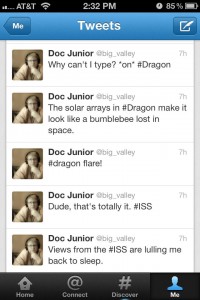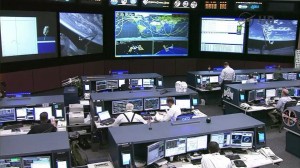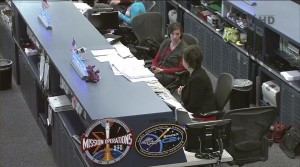We did get up to watch the ISS + Dragon capsule flyover at five o’clock this morning. The pair came up in the west, reached a maximum altitude of 36 degrees, and set in the north-northeast. Dragon is a pretty subtle beast–I’m not sure we would’ve been able to spot it in the slide into astronomical dawn if we hadn’t known to follow the path of the ISS. It doesn’t come close to the magnitude of the Space Shuttle. Once Catherine broke out the binoculars, however, we had a great view. Since Dragon trailed the ISS by only two degrees or so, both spacecraft fit in the magnified field of view.
I had every intention of going back to bed after the four-minute flyover, but of course, I had to tweet about it and so got sucked into watching NASA’s coverage of the Dragon fly-under of the ISS.
That little gray dot at vertical center, left of horizontal center, is Dragon, just making its presence known. Just after I clicked the button to capture this screen shot, I saw a Dragon flare. Flares are fairly common with iridium satellites (you can use Heavens Above to track them), but I wasn’t expecting to see one this morning, even via the computer screen. You can see my excitement on twitter:
I snapped a photo of the bumblebee, but it’s even more apparent in NASA’s video of this morning’s ISS fly under. I wish they would’ve picked up the video earlier so you could hear Astronaut Don Petit’s call: “I’m looking at Dragon right now.”
Today was about testing the system. While the fly-under brought Dragon within 2.5 km of the ISS—in other words, exactly where it was supposed to be at the time—more exciting was the moment the capsule’s strobe light powered on in response to a command issued from the ISS. This confirms that the ISS astronauts can communicate with the capsule, a necessity when guiding it into its dock on Friday, May 25, 2012.
There was a lot of downtime in this morning’s broadcast. As you can see by my twitter feed, the images from the ISS were soothing and soporific. Initially, so were the images of Mission Control, but the longer I watched, the more fascinating those silent rooms seemed to me. Take a look at this screen capture of Mission Control at Houston:
A bunch of guys in long-sleeved dress shirts and ties, staring a very large arrays of computer monitors. From the above vantage point, those desks look completely useless, all that dead space behind the monitors. But when you look backward across the room…
…you can see that the desks operate as shelves for the people sitting in the rows just in front of them. Nice adaptation. Still, Mission Control looks like what you’d expect: desks, ties but no suit jackets (except that one guy!), staring at screens, looking as if they’re hidden in a bunker. The women in the room are the exception to the dress code. Today, the voice of Mission Control was wearing red:
You might also have noticed that NASA has tossed a few toy dragons around the room. Even so, nothing in this room really leaps out as “Not NASA.” NASA tends to update, never fully overhaul, their aesthetics and spatial arrangements. This point became very clear whenever SpaceX Mission Control in Hawthorne, California, came on the screen.
That is not a room put together by NASA. That looks like every IT conference or training program I’ve ever attended, and I’ve attended a lot. I see a suit, but I also see the ubiquitous polo shirt and button-up short-sleeve dress shirt. And I swear that’s a baseball cap down front. I see light coming in through floor-to-ceiling glazing (check out Ian O’Neill’s launch day photo of the same space). No rigid rows—hierarchy is subtly undermined by those bent tables. We’re looking at an entirely different space culture than the one cultivated by NASA. A quick-and-dirty reading of the two Mission Controls could lead to the conclusion that private industry embraces transparent operations, while the NASA (the U.S. Government) still operates in Cold War super secrecy. I know this isn’t exactly true, but that’s the message the architecture is sending out. If I was NASA, and I wanted to be part of the future of space exploration, I’d do something about the contrast between the two images.






